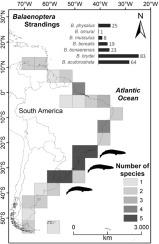Regional Studies in Marine Science ( IF 2.1 ) Pub Date : 2020-06-23 , DOI: 10.1016/j.rsma.2020.101343 Lucas Milmann , Salvatore Siciliano , Igor Morais , Andrea Sebastiano Tribulato , Rodrigo Machado , Alexandre N. Zerbini , Julio E. Baumgarten , Paulo Henrique Ott

|
The genus Balaenoptera comprises seven species and 15 subspecies whose conservation statuses range from “Endangered” to “Least Concern” and “Data Deficient”. In addition to data from whaling and offshore cruises, much of the information related to these whales in the Southwestern Atlantic Ocean (SWAO) comes from beached carcass analysis. We reviewed published and unpublished confirmed records of Balaenoptera strandings along the east coast of South America (from N to 55S) to evaluate spatio-temporal ecological and habitat use patterns. A total of 223 strandings from the seven species were documented from 1865 to 2018: B edeni, more recently referred to as B. brydei in the SWAO (n=83), B. acutorostrata (n=64), B. bonaerensis (n=23), B. borealis (n=19), B. physalus (n=25), B. musculus (n=8), and B. omurai (n=1). As expected, most of the species occurred in higher numbers during the winter and spring migration seasons to/from low latitudes. Balaenoptera brydei and some individuals of B. acutorostrata were found year-round along the Brazilian coast. Although we may be underestimating the total number of strandings because unidentified whales were not included, and some records were probably not recorded considering the vast area as well as effort differences among regions, this is the most complete data set for strandings in Eastern South America. This supported different theories, such as possible sexual segregation for B. borealis (especially of pregnant females), a calving area for the same species in mid-latitude waters of the SWAO, and a larger B. acutorostrata calving area than previously expected (from S to 35S). The apparent increase in efforts towards beach surveys in Eastern South America, such as a network for marine mammal stranding information in Brazil (REMAB), will be of great value to fill knowledge gaps related to Balaenopteridae species in the area.
中文翻译:

南美洲东海岸的Bal翅搁浅的回顾
属鲸包括七个种类和亚种15其保护状态的范围从“濒危”到“最不相关”和“数据缺乏”。除了捕鲸和近海航行的数据以外,西南大西洋(SWAO)中与这些鲸鱼有关的许多信息都来自搁浅的beach体分析。我们回顾了南美东海岸的published翅搁浅的已发表和未发表的确凿记录(来自N至55S)评估时空生态和栖息地使用模式。从1865年到2018年,共有7种物种的223条绞线记录在案:B edeni(最近在SWAO中被称为B. brydei(n = 83),B。acutorostrata(n = 64),B。bonaerensis(n = 23),B。北极(n = 19),B. physalus(n = 25),B . 家鼠(N = 8),和乙。omurai(n = 1)。不出所料,大多数物种在冬季和春季向低纬度/低纬度的迁移季节出现的数量更多。Balaenoptera brydei和一些个体乙。acutorostrata全年在巴西沿岸被发现。尽管由于未包括未认出的鲸鱼,我们可能低估了搁浅的总数,并且考虑到大面积地区和不同地区之间的工作差异,可能未记录一些记录,但这是南美东部搁浅的最完整数据集。这支持了不同的理论,例如B可能的性别隔离。北欧化工(特别是怀孕的女性),一个区产犊在水域中纬度的SWAO的相同物种,且较大的乙。acutorostrata产犊面积比以前预期的多(来自S至35S)。在对南美洲东部,海滩的调查工作,如在巴西(REMAB)的海洋哺乳动物搁浅信息网络的明显增加,将有很大的价值,相关填补知识空白,Balaenopteridae在该地区的物种。











































 京公网安备 11010802027423号
京公网安备 11010802027423号